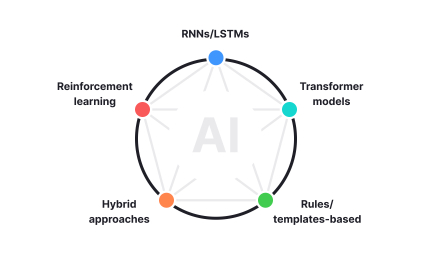Machine Learning UX
Machine learning UX focuses on designing interfaces that clearly communicate algorithmic behavior, outputs, and user control within smart systems.
What is Machine Learning UX?
AI-powered features in your product feel unpredictable or unhelpful to users, even though the underlying algorithms work correctly. You've probably seen machine learning implementations that technically function but create user experiences that feel frustrating, opaque, or untrustworthy.
Most ML-powered products fail at user experience because teams focus on algorithm performance instead of human-centered design, creating technically impressive features that people don't understand or want to use.
Machine Learning UX is the discipline of designing user experiences for AI-powered features that make algorithmic decisions transparent, controllable, and valuable to users through thoughtful interface design, feedback systems, and interaction patterns that build trust and understanding.
Products with well-designed ML experiences see 60-80% higher feature adoption, 45% better user satisfaction, and significantly lower abandonment rates compared to AI features that feel like "black boxes" to users.
Think about how Netflix's recommendation system works: it doesn't just show you movies, it explains why ("because you watched..."), lets you rate suggestions, and learns from your feedback. That's machine learning UX done right. It's transparent, controllable, and continuously improving.
Why Machine Learning UX Matters for Product Teams
Your AI features have impressive accuracy metrics but poor user adoption because people don't understand how they work, can't control outcomes, or don't trust the suggestions and predictions your algorithms generate.
The cost of poor ML UX is substantial. You get low feature utilization despite high development costs, user frustration with "smart" features that feel dumb, and competitive disadvantage against products whose AI feels more helpful and trustworthy.
What thoughtful Machine Learning UX delivers:
Higher feature adoption because users understand what AI features do, when to use them, and how to get better results through interaction and feedback.
When users understand that rating movies improves recommendations, they engage more. When they don't understand the system, they ignore it or actively avoid it.
Increased user trust through transparent algorithmic decision-making that shows users why specific recommendations or predictions were generated and how they can influence future results.
Better algorithm performance because well-designed feedback loops allow users to correct mistakes and provide training data that improves ML model accuracy over time.
Reduced support costs because users can troubleshoot and optimize AI features themselves rather than needing help understanding why algorithms behave in specific ways.
Competitive differentiation through AI experiences that feel magical but controllable, building user loyalty and word-of-mouth promotion that's hard for competitors to replicate.
Advanced Machine Learning UX Approaches
Once you've established basic ML UX principles, implement sophisticated human-AI interaction approaches.
Adaptive Interface Design: Create interfaces that adjust complexity and information density based on user expertise and familiarity with AI features, providing appropriate guidance for different user sophistication levels.
Contextual AI Integration: Design ML features that activate contextually when they're most valuable rather than being always-on, reducing cognitive overhead while maximizing utility.
Collaborative Intelligence Patterns: Build workflows where AI handles routine analysis while humans focus on creative problem-solving and strategic decision-making, optimizing for complementary strengths.
Ethical AI Communication: Design interfaces that communicate AI limitations, potential biases, and appropriate usage boundaries to help users make informed decisions about when to trust algorithmic suggestions.
Step 1: Make AI Decisions Explainable (Week 1-2)
Design interfaces that show users why your ML system made specific recommendations, predictions, or classifications. Use natural language explanations, visual indicators, and contextual information that help users understand algorithmic reasoning in terms they can relate to their goals.
Users who engage more confidently with AI features because they understand the basis for algorithmic suggestions and can evaluate their relevance.
Step 2: Design User Control and Feedback Mechanisms (Week 2-3)
Create ways for users to influence ML outcomes through preferences, corrections, and explicit feedback. Include thumbs up/down ratings, "not interested" options, preference adjustments, and manual override capabilities that give users agency over algorithmic decisions.
This makes users feel like partners with the AI rather than passive recipients of mysterious recommendations.
Step 3: Handle Uncertainty and Confidence Gracefully (Week 3)
Show users when your ML system is confident versus uncertain about predictions or recommendations. Use confidence indicators, alternative suggestions, and graceful degradation that maintains usefulness even when algorithms can't provide high-confidence results.
Users who trust AI features more because they understand system limitations and can make informed decisions about when to rely on algorithmic suggestions.
Step 4: Design Progressive AI Disclosure (Week 3-4)
Introduce ML complexity gradually, starting with simple, obviously valuable features before expanding to more sophisticated algorithmic capabilities. Help users build mental models of how AI works in your product through progressive experience.
Step 5: Create Human-AI Collaboration Patterns (Week 4-5)
Design workflows where humans and AI work together effectively, with clear handoffs between algorithmic suggestions and user decision-making. Avoid replacing human judgment entirely; instead, augment human capabilities with AI insights.
More effective user outcomes because AI enhances human decision-making rather than trying to replace it completely.
If users avoid AI features despite their accuracy, focus on explainability and control rather than improving algorithmic performance. Trust issues usually stem from transparency problems, not accuracy problems.
The Problem: AI features that work well in testing but feel unpredictable in real usage contexts.
The Fix: Test ML UX with diverse, realistic user scenarios rather than clean datasets. Design for edge cases and graceful failure modes that maintain user trust when algorithms struggle.
The Problem: Users who don't understand how to get better results from AI features.
The Fix: Create onboarding experiences that teach users how to train and optimize AI features through their interaction patterns and explicit feedback.
The Problem: AI features that feel creepy or invasive despite providing valuable functionality.
The Fix: Design transparent data usage communication and user control over what information algorithms can access. Let users understand and control the privacy-functionality tradeoff.
Create AI feature success metrics that balance algorithmic accuracy with user satisfaction and adoption rates. The best ML UX optimizes for user value, not just technical performance.
Recommended resources
Courses

Enhancing UX Workflow with AI

Psychology Behind Gamified Experiences

AI Fundamentals for UX
Lessons

AI’s Role in Text Generation and Modification

AI Limitations in User Research








